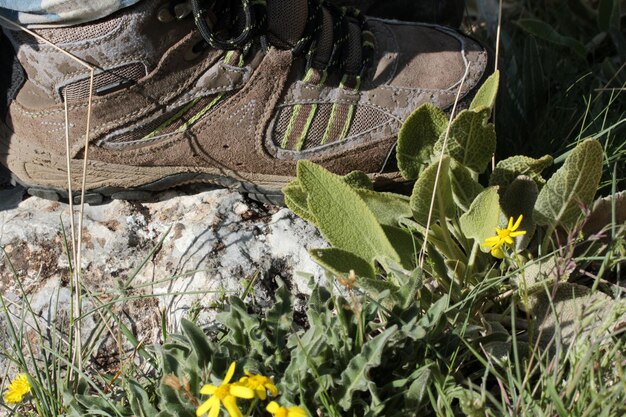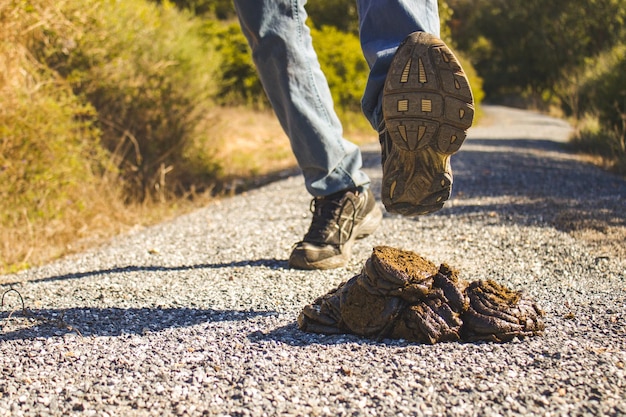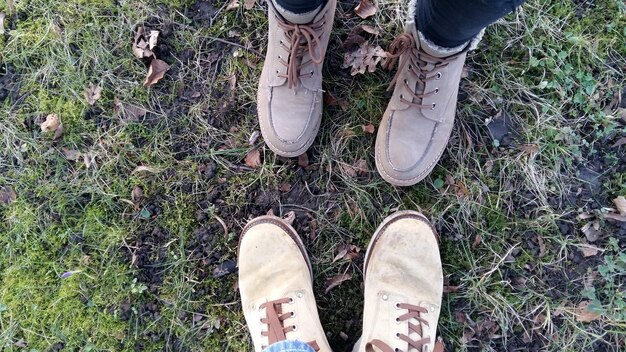How to Choose Hiking Boots for National Parks: Terrain Guide

Choosing the right hiking boots for different national park terrains involves considering factors such as ankle support, sole type, material, and fit to ensure comfort and prevent injuries on various trails.
Embarking on a hike through one of America’s stunning national parks is an unforgettable experience. But to truly enjoy the journey, having the right gear is essential, and that starts with your footwear. Knowing How to Choose the Right Hiking Boots for Different National Park Terrain can make or break your adventure.
Understanding Terrain Types in National Parks
National parks showcase a diverse range of landscapes, from rugged mountains to sandy deserts. Understanding the specific terrain you’ll encounter is the first step in selecting the right hiking boots. This knowledge will guide your decision on the level of support, traction, and durability needed for your footwear.
Rocky Mountain Trails
Rocky mountain trails demand boots with excellent ankle support and a stiff sole to protect your feet from sharp rocks. Look for boots with durable leather or synthetic uppers and aggressive lug patterns on the outsole.
Desert Hiking
In desert environments, breathability is key. Opt for lightweight boots with mesh panels to allow airflow and prevent overheating. Ensure the boots have good traction for navigating sandy and rocky surfaces.

- Ankle Support: High-cut boots offer the best protection against ankle twists and sprains.
- Sole Stiffness: A rigid sole provides stability and prevents foot fatigue on uneven terrain.
- Traction: Deep, aggressive lugs ensure a solid grip on loose rocks and steep inclines.
Choosing the right boots for rocky mountain trails requires careful consideration of support, durability, and traction to ensure a safe and enjoyable hiking experience.
Types of Hiking Boots: A Comprehensive Overview
Hiking boots come in various styles, each designed for specific types of hiking. Understanding the differences between these types will help you narrow down your choices based on your intended national park adventures. From lightweight hikers to heavy-duty backpacking boots, there’s a boot for every terrain and trail.
Lightweight Hiking Shoes
These are best suited for well-maintained trails and day hikes. They offer flexibility and comfort but may lack the support needed for rougher terrain.
Mid-Cut Hiking Boots
Mid-cut boots provide more ankle support and are a good choice for moderate trails with some uneven surfaces. They balance flexibility and support well.
Backpacking Boots
Backpacking boots are designed for carrying heavy loads over long distances on challenging terrain. They offer maximum support, durability, and protection.

- Weight: Consider the weight of the boots, especially for longer hikes. Lighter boots reduce fatigue.
- Material: Leather boots offer durability and water resistance, while synthetic boots are lighter and dry faster.
- Construction: Look for boots with sturdy construction and reinforced toe and heel areas for added protection.
Selecting the right type of hiking boot depends on the intensity and duration of your hikes, as well as the types of terrain you’ll be encountering in the national parks.
Assessing Key Features: Support, Sole, and Material
Beyond the type of boot, several key features contribute to its performance and comfort on the trail. These include the level of support, the type of sole, and the materials used in construction.
Ankle Support
Ankle support is crucial for preventing injuries, especially on uneven terrain. High-cut boots offer the most support, while low-cut boots provide more flexibility.
Sole Type
The sole of a hiking boot determines its traction and stability. Look for aggressive lug patterns for better grip on various surfaces.
Material Matters
The material of the upper affects the boot’s durability, water resistance, and breathability. Leather, synthetic, and nylon are common choices, each with its own set of advantages.
Choosing boots with the right level of ankle support, sole type, and material ensures comfort, stability, and protection on diverse terrains.
The Importance of Proper Fit
Even the best hiking boots will be uncomfortable if they don’t fit properly. A well-fitted boot prevents blisters, reduces foot fatigue, and enhances your overall hiking experience. Trying on boots with hiking socks and walking around the store can help you assess the fit accurately.
- Length: Ensure there’s enough room in the toe box to accommodate your toes, especially when hiking downhill.
- Width: The boot should fit snugly around your foot without feeling too tight or too loose.
- Heel Fit: Your heel should stay securely in place to prevent slippage and blisters.
Proper fit is paramount in choosing hiking boots. Ensure that there is adequate space and proper support for comfort and safety during a hike.
Waterproofing and Breathability Considerations
Waterproofing and breathability are important factors to consider, depending on the climate and conditions of the national parks you plan to visit. Waterproof boots keep your feet dry in wet environments, while breathable boots prevent sweat buildup and overheating.
Waterproof Membranes
Boots with waterproof membranes like Gore-Tex offer excellent protection against rain and moisture, keeping your feet dry and comfortable.
Breathable Materials
Breathable materials like mesh allow air to circulate, preventing your feet from overheating and reducing the risk of blisters.
Balancing waterproofing and breathability ensures comfort and protection in various weather conditions, allowing you to enjoy your hike without discomfort.
Maintenance and Care for Hiking Boots
Proper maintenance and care can extend the life of your hiking boots and ensure they perform optimally on every adventure. Cleaning, conditioning, and storing your boots correctly will protect them from damage and wear.
- Cleaning: Remove dirt and debris after each hike using a brush and mild soap.
- Conditioning: Apply a leather conditioner to prevent drying and cracking, especially for leather boots.
- Storage: Store your boots in a cool, dry place away from direct sunlight to prevent damage.
Regular maintenance and care ensure long-lasting performance and protect your investment in quality hiking boots.
| Key Factors | Brief Description |
|---|---|
| ⛰️ Terrain Types | Consider terrains like rocky, desert, or forest when choosing boots. |
| 🥾 Boot Types | Select from lightweight, mid-cut, or backpacking boots based on hike intensity. |
| 👣 Proper Fit | Ensure enough toe space, snug width, and secure heel fit to prevent blisters. |
| 💧 Waterproofing | Balance waterproofing and breathability for comfort in diverse conditions. |
[Frequently Asked Questions]
▼
For rocky terrain, choose boots with high ankle support, a stiff sole, and aggressive lug patterns. These features provide stability and protect your feet from sharp rocks.
▼
Try on boots with hiking socks and ensure there’s enough toe space, a snug fit around your foot, and a secure heel fit. Walk around to assess comfort and prevent slippage.
▼
Waterproof boots are ideal for wet conditions but may not be necessary for dry climates. Consider the weather and terrain of the park you plan to visit when deciding.
▼
Clean your hiking boots after each hike to remove dirt and debris. Regular cleaning helps maintain the material and prolongs the life of your boots.
▼
In hot weather, opt for boots made with breathable materials like mesh or lightweight synthetics to allow air circulation and prevent overheating of your feet.
Conclusion
Choosing the right hiking boots for different national park terrains is crucial for a safe and enjoyable hiking experience. By considering factors like terrain type, boot style, key features, fit, and maintenance, you can find the perfect pair that provides comfort, support, and protection on any trail.





